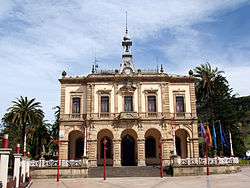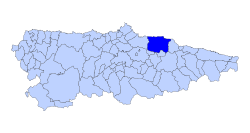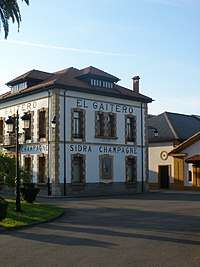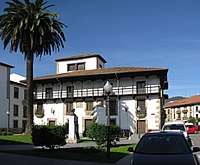Villaviciosa, Asturias
Villaviciosa (Spanish pronunciation: [biʎaβiˈθjosa]) is a town and municipality in the autonomous community of Asturias, Spain.[2] José Ángel Hevia Velasco was born in the town.[3] Villaviciosa is important for the production of cider. The town also produces milk and relies on tourism, with natural landscapes and beaches.
Villaviciosa | |
|---|---|
 Villaviciosa city hall | |
 Flag .svg.png) Coat of arms | |
 Location of Villaviciosa | |
 Villaviciosa Location in Spain | |
| Coordinates: 43°29′N 5°26′W | |
| Country | |
| Autonomous community | |
| Province | Asturias |
| Comarca | Gijón |
| Founded | 17 October 1270 |
| Capital | Villaviciosa |
| Government | |
| • Alcalde | Manuel Busto Alonso (Unión Asturianista) |
| Area | |
| • Total | 276.23 km2 (106.65 sq mi) |
| Elevation | 662 m (2,172 ft) |
| Population (2018)[1] | |
| • Total | 14,430 |
| • Density | 52/km2 (140/sq mi) |
| Demonym(s) | maliayo/a |
| Time zone | UTC+1 (CET) |
| • Summer (DST) | UTC+2 (CEST) |
| Postal code | 33300 and 33310 al 33318 |
| Official language(s) | Spanish |
| Website | Official website |
Geography



pre-romanesque style
Villaviciosa is situated on the central eastern coastline, and borders the Asturian municipalities of Gijón and Siero to the west, Sariego, Nava, Cabranes and Piloña to the south and Colunga to the east. The total area is 276.23 square kilometres (106.65 sq mi)
Demographics
It had a population of 14,962 in 2011.
History
In prehistory, several Hill forts surrounded Villaviciosa, most located in the axis of the ria, near Rodiles. During the time of the Kingdom of Asturias in the 8th century, the population migrated to areas such as Amandi, Camoca, and Bedriñana, appearing frequently in the Maliayo territory.
By the time of Alfonso IX of León, in the 13th century, the municipality had begun to repopulate, as witnessed in 17 October 1270, when King Alfonso X The Wise created the document evidencing the establishment of a population in Buetes. At the same time, a Cistercian Order emerged in the valley of Boides creating the Monasterio de Santa María de Valdediós.
In the 16th century, Holy Roman Emperor Charles V landed and was hosted in the town (the most important event in village history). The King arrived at the port of Tazones due to a storm that altered his course on the way to Santander.
In the 19th century, the town was repeatedly attacked. It was occupied several times by French troops during the Peninsular War. In 1835, the community was officially established and municipal business grew significantly due to its location on the river, which at the time was navigable.
Parroquias
The capital is the town of the same name. It is 2 km2 (0.77 sq mi) in size.
Villaviciosa includes 41 parroquias (parishes):
|
References
- Municipal Register of Spain 2018. National Statistics Institute.
- "Portada - Ayuntamiento de Villaviciosa". www.villaviciosa.es. Retrieved 16 January 2019.
- "Hevia - MusicBrainz". musicbrainz.org. Retrieved 16 January 2019.